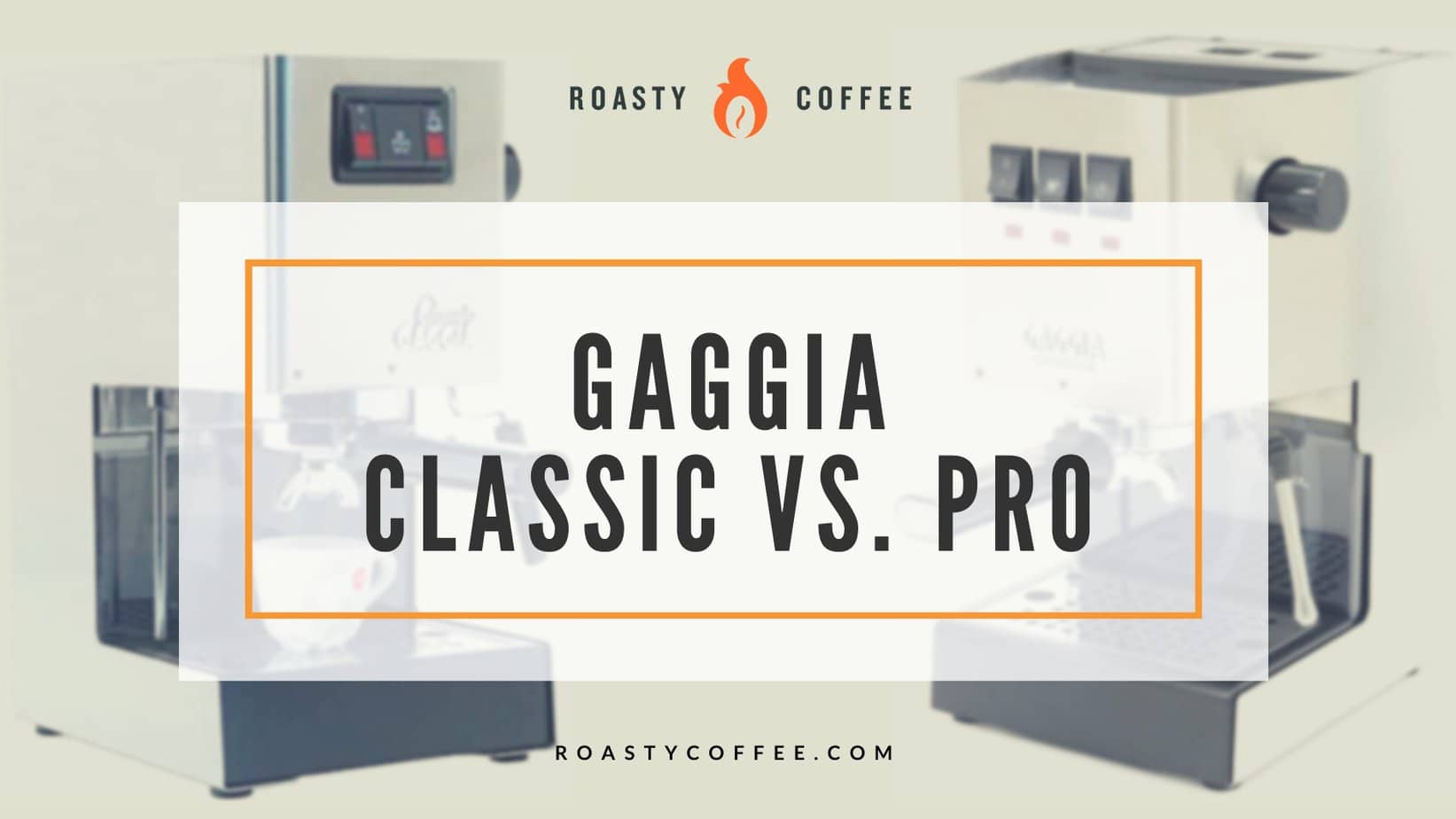If you’re looking for a semi-automatic espresso machine that delivers quality espresso with no fluff, the Gaggia Classic is, well, a classic! But in over 30 years of popularity, has this reputable espresso machine brand made any changes? Is the newer Classic Pro espresso machine really an upgrade from the old standby?
We’ve got all of the details here, and as it turns out, the answer isn’t as simple as you might think.

An Overview
| Gaggia Classic (pre-2009) | Gaggia Classic 2015 | Gaggia Classic Pro | |
|---|---|---|---|
| Body Materials | Stainless Steel | Stainless Steel, some plastic elements | Stainless Steel (colored body available) |
| Boiler Materials | Aluminum | Stainless Steel | Aluminum |
| # of boilers | Single | Single | Single |
| Steam Wand | Panarello | Panarello | Professional Steam Wand |
| Controls | Rocker Switches | Push Buttons | Rocker Switches |
| Water Tank Size | 72 oz | 72 oz | Around 2 minutes |
| Time to Heat* | Around 2 minutes | 5 minutes or more | As little as 45 seconds |
| Country Manufactured | Italy | Romania | Italy |
| Solenoid Valve? | Yes | No | Yes |
*Many users and reviews disagree about the heating times that each machine requires, but they do agree that the aluminum boilers present in the pre-2009 Classic and the new Classic Pro heat more quickly than the stainless steel boiler of the 2015 Classic.
Gaggia: A Trailblazer in the World of Espresso
Gaggia is an iconic Italian manufacturer of coffee makers, especially espresso machines, that has been around for nearly a century. It was established by Achille Gaggia, who worked in his family’s coffee bar and wanted to improve the flavor and quality of the espresso they produced.
Gaggia patented the mechanism for using pressurized hot water, rather than steam, to make espresso in 1938. Soon after, he patented his lever-piston mechanism, which allowed the barista to use a lever to force hot water through coffee grounds and produce a beautifully extracted espresso in just 25-30 seconds.
These mechanisms were revolutionary, and they shaped the way espresso was brewed. If you’ve ever enjoyed a delicious and balanced espresso topped with a thick layer of crema, you can thank Gaggia!
Gaggia was acquired by Saeco in 1999, and both companies were sold ten years later to Royal Philips Electronics. However, Gaggia espresso machines are still manufactured in Italy under the Gaggia label and remain respected and high-quality espresso machines for home use.
Gaggia Classic History
The Gaggia Classic was released in 1991 and remained the same until Philips bought the company in 2009.
Though you’ll have to do some hunting if you’d like to buy one second-hand, there are still plenty of these rock-solid espresso machines floating around out there, and parts for them are readily available.
You can identify pre-2009 Gaggia Classic machines by the “made in Milan” sticker on the back.
The most controversial changes to the Gaggia Classic came with the 2015 updates to the popular espresso machine, which included removing the 3-way solenoid valve and replacing the rocker switches with push buttons. The 2015 Classic was also manufactured in Romania rather than Italy.
The steam wand on the 2015 Gaggia Classic is also difficult to remove and replace, which is a bummer for coffee heads who want to mod their machine with a different steam wand (The Rancilio Silvia wand was a popular choice).
In 2019, the Gaggia Classic Pro was released, and many of these changes were rolled back.
Gaggia Classic Pro History and Updates
My mama always told me: if it ain’t broke, don’t fix it. The Philips company must have eventually come to the same conclusion because, in 2019, they released the Gaggia Classic Pro, which reverted to many of the features found in the pre-2009 Gaggia Classic.
The 3-way solenoid valve is back for this model, along with rocker switches, a stainless steel and aluminum construction, and the distinction of being manufactured in Italy.
The Gaggia Classic Pro also sports a professional steam wand, which improves upon one of the Gaggia Classic’s biggest flaws.
This professional wand will allow you to crank out plenty of microfoam to fulfill your latte art dreams. There’s a learning curve involved in using this commercial-style steam wand, but like all things espresso, it’s well worth the effort!
Gaggia Classic vs Gaggia Classic Pro: Which Is Best For You?
The Gaggia Classic and Gaggia Classic Pro are both entry-level semi-automatic machines, and you’ll find that they are quite similar.
However, there are a few differences to note when considering which machine is the best fit for your kitchen. Let’s examine these further below.
Similarities Between the Gaggia Classic and Gaggia Classic Pro
The Gaggia Classic Pro and Gaggia Classic both sport a brushed stainless steel housing that looks solid and rugged (or industrial, depending on who you ask). They weigh around 20 pounds, making this machine one you’ll probably want to leave in place on your counter.
Both machines are configured with small, traditional espresso cups in mind- you won’t be able to fit a giant American-style mug under the spout.
Both machines come with a solid, high-quality 58 mm portafilter, which will allow you to pull double shots with ease. They also both come with a tamper, although the included version is nothing to write home about. We’d recommend upgrading.
Neither machine comes with a built-in coffee grinder, so anyone considering one of these espresso machines should factor in the cost of purchasing a high-quality grinder and a scale for dosing.
Gaggia Classic Pre-2009
The Gaggia Classic manufactured prior to 2009 enjoyed a long and successful run, and you’ll find plenty of these straightforward machines still pulling shots today.
These espresso machines featured a stainless steel housing, rocker switches for operation, and a single aluminum boiler.
With practice, these machines deliver a great shot of espresso, and they’re a fantastic way for espresso newbies to dive into a new hobby.
One downside of the pre-2009 Classic was its Panarello-style steam wand, which was fine for frothing milk for a latte but couldn’t produce the type of dry foam that characterizes a great cappuccino.
Many dedicated espresso junkies get around this by replacing the wand with a Rancilio Silvia wand, which is simple and inexpensive to do.
The pre-2009 Gaggia Classic might be for you if you’re intrigued by the idea of buying a workhorse secondhand espresso machine that still has plenty to give.
There’s a huge community of users of this machine out there who will chat with you about how best to use this machine and even mod it if you so desire. It’s a classic for a reason and is a great machine to consider if you’re getting into espresso-making as a hobby!
What We Like:
- Three-way solenoid valve
- Easy to modify
- Simple user interface
- A large community of users to learn from
What We Don’t:
- The single boiler requires some temperature surfing
- The steam wand doesn’t produce dry foam
- Included tamper is cheap and flimsy
Gaggia Classic 2015
The Gaggia Classic 2015 made a few changes to the Gaggia Classic, and few of them were well-received.
This model was made in Romania, rather than Italy. It had more plastic components, though the housing was still made of stainless steel. It featured the same subpar Panarello wand as the earlier Gaggia Classic, but this one was more difficult to remove and modify.
The 2015 Classic didn’t have a 3-way solenoid valve, which was an unpopular change. It also featured push buttons instead of rocker switches, which gained a reputation for sticking.
The other major change to the 2015 edition of this machine was a stainless steel boiler, rather than an aluminum one. The change was made to avoid corrosion issues, but also led to a slower heat-up time.
Despite the unpopular changes, it’s important to note that this espresso machine still has the potential to create a great shot of espresso. Since it’s a less popular model, it could be a great way to get an affordable espresso machine for someone who is just getting into the hobby.
What We Like:
- Comes with a high-quality portafilter
- Can be an affordable choice
- Pulls a quality shot of espresso
- The boiler is less susceptible to corrosion
What We Don’t:
- No 3-way solenoid valve
- Can be slower to heat
- More plastic components
- Buttons can be sticky
Gaggia Classic Pro
With the Gaggia Classic Pro, Philips rolled back many of the unpopular changes that were made to the 2015 Classic.
The Gaggia Classic Pro has a three-way solenoid valve, which removes pressure from the group head so that the portafilter can be removed immediately after your shot is brewed. The puck will be nice and dry, making cleanup easier.
The simple rocker switch interface is back for the Gaggia Classic Pro, as is the aluminum boiler. This boiler allows for much quicker heat-up times, so you’ll have your life-giving beverage in hand sooner.
Perhaps the most welcome change to the Gaggia Classic Pro is the commercial steam wand. This wand will allow cappuccino lovers to create the dry microfoam of their dreams and is great for latte art.
Just like its earlier edition counterparts, the Gaggia Classic Pro does not have an option for pre-infusion, which is disappointing.
The classic brushed stainless steel housing is still available for the Gaggia Classic Pro, and we personally don’t think you can go wrong with this look. However, you can also buy this model in red, blue, grey, white, or black, plus a special edition design that features a design with an acrobat drinking espresso on the front of the machine.
The Gaggia Classic Pro is a great choice for anyone getting started with espresso making as a hobby, especially for anyone interested in developing their milk-frothing and latte art skills. If cost isn’t a factor, the Pro model offers everything that the Classic offers, plus more.
What We Like:
- The 3-way solenoid valve is back
- Quick heat-up time
- Professional steam wand
What We Don’t:
- Some users think the 15-bar pressure is too high
- No pre-infusion
Alternatives
While we’re eternally grateful to Gaggia for creating the espresso as we know it today, there are many more options available now than there were in Achille Gaggia’s day, or even in 1991 when the Classic was first released.
The Gaggia Classic and Classic Pro are semi-automatic espresso machines, which means they offer plenty of control over the shot while still taking over some of the brewing processes. (You’ll notice that there’s no lever on the Classic- all you have to do to pull your shot is flip a switch).
To best compare apples to apples, let’s take a look at some other semi-automatic espresso machines on the market.
| Gaggia Classic | Gaggia Classic Pro | Breville Barista Touch | Rocket Appartamento | |
|---|---|---|---|---|
| Construction | Stainless Steel (with some plastic) | Stainless Steel | Stainless Steel | Stainless Steel |
| # of Boilers | Single | Single | Single | |
| Steam Wand Type | Panerello | Professional Steam Wand | Automatic Steam Wand | Cool touch insulated steam wand |
| Portafilter Size | 58 mm | 58 mm | 54 mm | 58 mm |
| Grinder | N/A | N/A | Built-in with 30 grind levels | Single Heat Exchange Boiler |
| Water Reservoir Size | 72 oz | 72 oz | 67 oz | 76 oz |
| Interface | Rocker switches (pre-2009) or buttons (2015) | Rocker Switches | Touchscreen | Knobs |
| Heat-Up Time | Varies, up to 5 minutes | 30 seconds to 2 minutes | 3 seconds | 20+ minutes |
Wrap Up
The Gaggia Classic and Classic Pro are both excellent entry-level options for anyone who is interested in learning to pull an espresso shot on a straightforward workhorse of an espresso machine.
If you have it in your budget, the Classic Pro offers a better steam wand and more color options, along with a return to fan-favorite features like the 3-way solenoid valve, stainless steel construction, and aluminum boiler.
If you’re buying secondhand, you’ll be able to closely imitate the Classic Pro experience with the Classic if you can score a model that was manufactured prior to 2009.
Happy Caffeinating!











